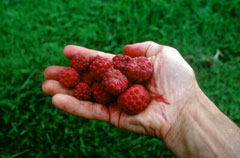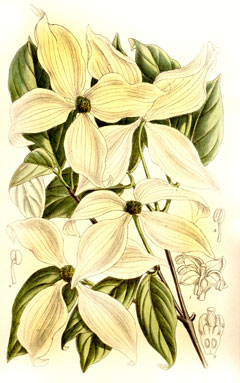 |
|
(c) 2010 Ken Fern & Plants For A Future |
 |
|
Translate this page:
Summary
Bloom Color: White.
Main Bloom Time: Early summer, Late spring. Form: Rounded.
Physical Characteristics

 Cornus kousa is a deciduous Tree growing to 10 m (32ft) by 6 m (19ft) at a slow rate.
Cornus kousa is a deciduous Tree growing to 10 m (32ft) by 6 m (19ft) at a slow rate.
See above for USDA hardiness. It is hardy to UK zone 5. It is in flower in June, and the seeds ripen from September to October. The species is hermaphrodite (has both male and female organs) and is pollinated by Insects.
Suitable for: light (sandy), medium (loamy) and heavy (clay) soils and can grow in heavy clay soil. Suitable pH: mildly acid, neutral and basic (mildly alkaline) soils. It can grow in semi-shade (light woodland) or no shade. It prefers moist soil.
UK Hardiness Map
US Hardiness Map
Synonyms
Plant Habitats
Woodland Garden Canopy; Secondary; Sunny Edge; Dappled Shade;
Edible Uses
Edible Parts: Fruit Leaves
Edible Uses:
Fruit - raw or cooked[61, 177]. Sweet and juicy[11, 183], it is very nice in small quantities[K]. Very seedy[105]. The skin is rather tough and unpleasant, but the pulp is delicious with a custard-like texture, it is one of our favourite late summer fruits[K]. The fruit is about 2cm in diameter[200]. Young leaves - cooked[105, 177, 183].
References More on Edible Uses
Medicinal Uses
Plants For A Future can not take any responsibility for any adverse effects from the use of plants. Always seek advice from a professional before using a plant medicinally.
None known
References More on Medicinal Uses
The Bookshop: Edible Plant Books
Our Latest books on Perennial Plants For Food Forests and Permaculture Gardens in paperback or digital formats.

Edible Tropical Plants
Food Forest Plants for Hotter Conditions: 250+ Plants For Tropical Food Forests & Permaculture Gardens.
More

Edible Temperate Plants
Plants for Your Food Forest: 500 Plants for Temperate Food Forests & Permaculture Gardens.
More

More Books
PFAF have eight books available in paperback and digital formats. Browse the shop for more information.
Shop Now
Other Uses
Wood
Wood - very hard and heavy. Used for mallets etc[151].
Special Uses
Food Forest
References More on Other Uses
Cultivation details
Landscape Uses:Pest tolerant, Specimen, Woodland garden. An easily grown plant, it succeeds in any soil of good or moderate fertility, from acid to slightly alkaline but dislikes shallow chalky soils[184, 188]. Grows well in heavy clay soils. Prefers a rich well-drained loamy soil and a position that is at least partially sunny[11]. A very ornamental plant[1], it is hardy to about -20°c[184]. A number of named forms have been developed for their ornamental value[182]. Plants are slow-growing when young, they speed up somewhat after a few years but then soon slow down again[202]. The sub-species of C. kousa chinensis grows more freely, flowering and fruiting better in Britain though it barely differs in appearance from the species[11]. This species has been known to hybridize with C. capitata[182]. The cultivar 'Norman Hadden' could be such a hybrid[182]. Plants in this genus are notably resistant to honey fungus[200]. Special Features:Attracts birds, Not North American native, Blooms are very showy. The plant is heat tolerant in zones 8 through 5. (Plant Hardiness Zones show how well plants withstand cold winter temperatures.
Plant Heat Zones show when plants would start suffering from the heat.
The Plant Heat Zone map is based on the number of "heat days" experienced in a given area where the temperature climbs to over 86 degrees F (30°C).
At this temperature, many plants begin to suffer physiological damage. Heat Zones range from 1 (no heat days) to 12 (210 or more heat days).
For example Heat Zone. 11-1 indicates that the plant is heat tolerant in zones 11 through 1.) For polyculture design as well as the above-ground architecture (form - tree, shrub etc. and size shown above) information on the habit and root pattern is also useful and given here if available. The plant growth habit is a standard with a non-suckering single trunk [1-2].
References Carbon Farming Information and Carbon Sequestration Information
Temperature Converter
Type a value in the Celsius field to convert the value to Fahrenheit:
Fahrenheit:
The PFAF Bookshop
Plants For A Future have a number of books available in paperback and digital form. Book titles include Edible Plants, Edible Perennials, Edible Trees,Edible Shrubs, Woodland Gardening, and Temperate Food Forest Plants. Our new book is Food Forest Plants For Hotter Conditions (Tropical and Sub-Tropical).
Shop Now
Plant Propagation
Seed - best sown as soon as it is ripe in a cold frame or in an outdoors seedbed if there is sufficient seed[80, 113]. The seed must be separated from the fruit flesh since this contains germination inhibitors[80, 164]. Stored seed should be cold stratified for 3 - 4 months and sown as early as possible in the year[164]. Scarification may also help as may a period of warm stratification before the cold stratification[80, 164]. Germination, especially of stored seed, can be very slow, taking 18 months or more[164]. Prick out the seedlings of cold-frame sown seeds into individual pots as soon as they are large enough to handle and grow the plants on for their first winter in a greenhouse, planting out in the spring after the last expected frosts. Cuttings of half-ripe side shoots, July/August in a frame[188]. Cuttings of mature wood of the current year's growth, taken with a heel if possible, autumn in a cold frame. High percentage[78]. Layering of new growth in June/July. Takes 9 months[78].
Other Names
If available other names are mentioned here
Native Plant Search
Search over 900 plants ideal for food forests and permaculture gardens. Filter to search native plants to your area. The plants selected are the plants in our book 'Plants For Your Food Forest: 500 Plants for Temperate Food Forests and Permaculture Gardens, as well as plants chosen for our forthcoming related books for Tropical/Hot Wet Climates and Mediterranean/Hot Dry Climates. Native Plant Search
Found In
Countries where the plant has been found are listed here if the information is available
Weed Potential
Right plant wrong place. We are currently updating this section.
Please note that a plant may be invasive in one area but may not in your area so it’s worth checking.
Conservation Status
IUCN Red List of Threatened Plants Status :

| Related Plants
|
| Latin Name | Common Name | Habit | Height | Hardiness | Growth | Soil | Shade | Moisture | Edible | Medicinal | Other |
| Cornus alba | Tartarian Dogwood | Shrub | 3.0 |
3-7
| F | LMH | SN | Mwe | 0 | 0 | 1 |
| Cornus alternifolia | Green Osier, Alternateleaf dogwood, Alternate Leaf Dogwood, Golden Shadows Pagoda Dogwood, Green Osi | Shrub | 6.0 |
3-8
| F | LMH | N | DM | 0 | 2 | 2 |
| Cornus amomum | Silky Dogwood | Shrub | 3.0 |
4-8
| M | LMH | SN | M | 1 | 2 | 1 |
| Cornus asperifolia drummondii | Roughleaf Dogwood | Shrub | 4.0 |
5-9
| F | LMH | N | M | 0 | 0 | 3 |
| Cornus australis | | Shrub | 4.0 |
6-9
| | LMH | SN | M | 1 | 0 | 3 |
| Cornus canadensis | Creeping Dogwood, Bunchberry dogwood, Bunchberry | Perennial | 0.3 |
2-7
| F | LMH | SN | M | 4 | 2 | 2 |
| Cornus capitata | Bentham's Cornel | Tree | 12.0 |
7-10
| M | LMH | SN | M | 4 | 1 | 3 |
| Cornus chinensis | | Tree | 10.0 |
7-10
| | LMH | SN | M | 2 | 3 | |
| Cornus controversa | Giant Dogwood, Wedding Cake Tree, | Tree | 15.0 |
5-8
| F | LMH | SN | M | 2 | 1 | 2 |
| Cornus coreana | | Tree | 20.0 |
5-9
| | LMH | SN | M | 0 | 0 | 2 |
| Cornus elliptica | | Tree | 10.0 |
7-10
| M | LMH | SN | M | 4 | 1 | 2 |
| Cornus florida | Flowering Dogwood | Shrub | 6.0 |
5-9
| M | LMH | SN | M | 2 | 2 | 3 |
| Cornus hemsleyi | | Shrub | 4.0 |
-
| | LMH | SN | M | 0 | 0 | 2 |
| Cornus hongkongensis | | Shrub | 15.0 |
-
| | LMH | SN | M | 1 | 0 | 2 |
| Cornus iberica | | Shrub | 4.0 |
-
| | LMH | SN | M | 2 | 0 | 3 |
| Cornus kousa chinensis | Japanese Dogwood | Tree | 10.0 |
5-8
| | LMH | SN | M | 5 | 0 | 2 |
| Cornus macrophylla | Large-Leaf Dogwood | Tree | 15.0 |
5-9
| | LMH | SN | M | 2 | 2 | 2 |
| Cornus mas | Cornelian Cherry, Cornelian Cherry Dogwood | Shrub | 5.0 |
4-8
| M | LMH | SN | M | 4 | 2 | 3 |
| Cornus monbeigii | | Shrub | 5.0 |
6-9
| | LMH | SN | M | 1 | 2 | 2 |
| Cornus multinervosa | | Tree | 8.0 |
-
| | LMH | SN | M | 2 | 0 | 2 |
| Cornus nuttallii | Mountain Dogwood, Pacific dogwood, Western Dogwood | Tree | 10.0 |
6-8
| M | LMH | SN | DM | 1 | 2 | 3 |
| Cornus oblonga | Oblong-Petal Dogwood | Tree | 6.0 |
8-11
| | LMH | SN | M | 0 | 3 | 2 |
| Cornus occidentalis | Western Dogwood | Shrub | 6.0 |
5-9
| | LMH | SN | M | 1 | 1 | |
| Cornus officinalis | Shan Zhu Yu, Asiatic dogwood, Japanese Cornel Dogwood | Shrub | 10.0 |
5-8
| M | LMH | SN | M | 4 | 3 | 0 |
| Cornus poliophylla | | Shrub | 4.0 |
6-9
| | LMH | SN | M | 1 | 2 | 2 |
| Cornus quinquenervis | | Shrub | 3.0 |
4-8
| | LMH | SN | M | 2 | 0 | |
| Cornus rugosa | Round-Leaved Dogwood | Shrub | 3.0 |
4-8
| | LMH | SN | DM | 0 | 1 | |
| Cornus sanguinea | Dogwood, Bloodtwig dogwood | Shrub | 3.0 |
4-8
| | LMH | SN | M | 2 | 1 | 3 |
| Cornus sericea | Red Osier Dogwood, Western dogwood | Shrub | 2.5 |
2-7
| F | LMH | SN | MWe | 2 | 2 | 4 |
|
|
Growth: S = slow M = medium F = fast. Soil: L = light (sandy) M = medium H = heavy (clay). pH: A = acid N = neutral B = basic (alkaline). Shade: F = full shade S = semi-shade N = no shade. Moisture: D = dry M = Moist We = wet Wa = water.

Expert comment
Author
Buerger. ex Hance.
Botanical References
11200266
Links / References
For a list of references used on this page please go here
Readers comment